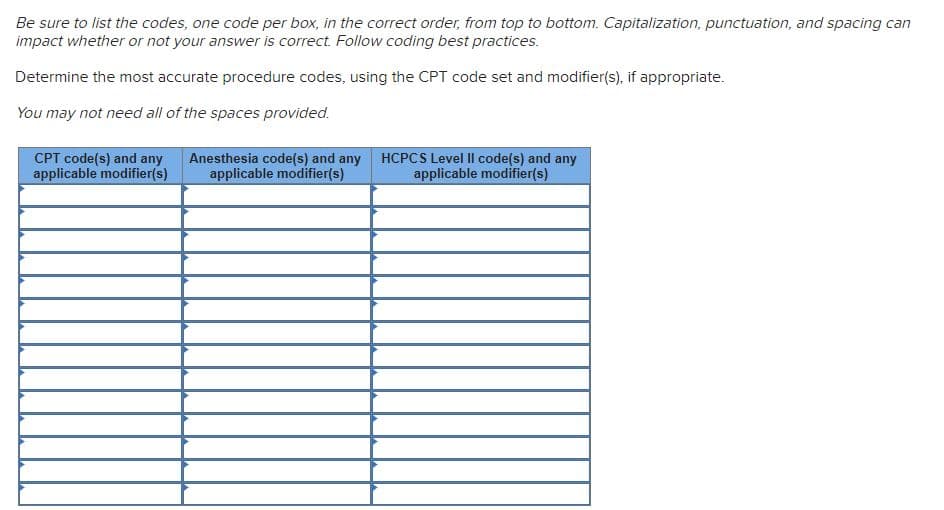Using the coding techniques described in this chapter, carefully read through the case study and determine the most accurate CPT code(s) and HCPCS code(s) and modifier(s), if appropriate. PATIENT: Tori Bensio Preop Diagnosis: Acute cholecystitis, cholelithiasis Postop Diagnosis: Acute cholecystitis, cholelithiasis Procedure: Laparoscopic cholecystectomy Surgeon: Anthony DeTaglia, MD Assistant: Robyn Acculo, MD Anesthesiologist: Benjamin Sullivan, MD Anesthesia: General endotracheal Findings at Surgery: Pericholecystic adhesions, large gallstones DESCRIPTION OF OPERATION: This otherwise healthy patient was brought to the OR and after the induction of general endotracheal anesthesia, the patient’s abdomen was prepped and draped in the usual sterile manner and a small infraumbilical incision was made in the skin and carried down to the linea alba, which was grasped with a clamp and incised in a vertical manner. The peritoneum was entered under direct vision. Stay sutures were placed in the fascia. The Hasson introducer was placed. Pneumoperitoneum was established, and following this, three additional trocars were placed in the abdomen: one in the left epigastrium and two in the right upper quadrant, all 5 mm. Following this, the gallbladder was grasped with cephalad retraction of the gallbladder fundus and lateralward retraction of the gallbladder infundibulum. The dissector was employed to take down the peritoneum overlying the gallbladder infundibulum and cystic duct junction. When this was well delineated on both the anterior and posterior surfaces of the cystic duct, the 5-mm endoscopic clip applier was inserted and two clips were placed on the patient’s side, on the gallbladder side of the cystic duct, which was transected. Further dissection in the triangle of Calot revealed the cystic artery, which was handled in an identical manner. The remainder of the dissection was performed by using the Bovie spatula cautery, and the liver bed was dry. A 10- to 15-mm camera change-out was performed, and the camera was inserted into the left epigastric port. A toothed clamp was passed through the umbilicus to grasp the gallbladder, which was then removed through the umbilicus in a standard manner. Following this, the operative field was copiously irrigated with saline and the return was clear. All three upper abdominal ports were seen to exit the abdomen under direct vision, and with the Hasson introducer removed, the fascial incision was closed with a 2-0 Vicryl figure-of-eight suture. The skin at the umbilicus was closed with a 4-0 Maxon subcuticular suture. Steri-strips were applied at all sites. The patient tolerated the procedure well. ADDENDUM: There were three cystic artery branches; each was doubly clipped and transected. Code for both Dr. DeTaglia and Dr. Sullivan.
Using the coding techniques described in this chapter, carefully read through the case study and determine the most accurate CPT code(s) and HCPCS code(s) and modifier(s), if appropriate.
PATIENT: Tori Bensio
Preop Diagnosis: Acute cholecystitis, cholelithiasis
Postop Diagnosis: Acute cholecystitis, cholelithiasis
Procedure: Laparoscopic cholecystectomy
Surgeon: Anthony DeTaglia, MD
Assistant: Robyn Acculo, MD
Anesthesiologist: Benjamin Sullivan, MD
Anesthesia: General endotracheal
Findings at Surgery: Pericholecystic adhesions, large gallstones
DESCRIPTION OF OPERATION: This otherwise healthy patient was brought to the OR and after the induction of general endotracheal anesthesia, the patient’s abdomen was prepped and draped in the usual sterile manner and a small infraumbilical incision was made in the skin and carried down to the linea alba, which was grasped with a clamp and incised in a vertical manner. The peritoneum was entered under direct vision. Stay sutures were placed in the fascia. The Hasson introducer was placed. Pneumoperitoneum was established, and following this, three additional trocars were placed in the abdomen: one in the left epigastrium and two in the right upper quadrant, all 5 mm. Following this, the gallbladder was grasped with cephalad retraction of the gallbladder fundus and lateralward retraction of the gallbladder infundibulum. The dissector was employed to take down the peritoneum overlying the gallbladder infundibulum and cystic duct junction. When this was well delineated on both the anterior and posterior surfaces of the cystic duct, the 5-mm endoscopic clip applier was inserted and two clips were placed on the patient’s side, on the gallbladder side of the cystic duct, which was transected. Further dissection in the triangle of Calot revealed the cystic artery, which was handled in an identical manner. The remainder of the dissection was performed by using the Bovie spatula cautery, and the liver bed was dry. A 10- to 15-mm camera change-out was performed, and the camera was inserted into the left epigastric port. A toothed clamp was passed through the umbilicus to grasp the gallbladder, which was then removed through the umbilicus in a standard manner. Following this, the operative field was copiously irrigated with saline and the return was clear. All three upper abdominal ports were seen to exit the abdomen under direct vision, and with the Hasson introducer removed, the fascial incision was closed with a 2-0 Vicryl figure-of-eight suture. The skin at the umbilicus was closed with a 4-0 Maxon subcuticular suture. Steri-strips were applied at all sites. The patient tolerated the procedure well.
ADDENDUM: There were three cystic artery branches; each was doubly clipped and transected.
Code for both Dr. DeTaglia and Dr. Sullivan.

Trending now
This is a popular solution!
Step by step
Solved in 2 steps









